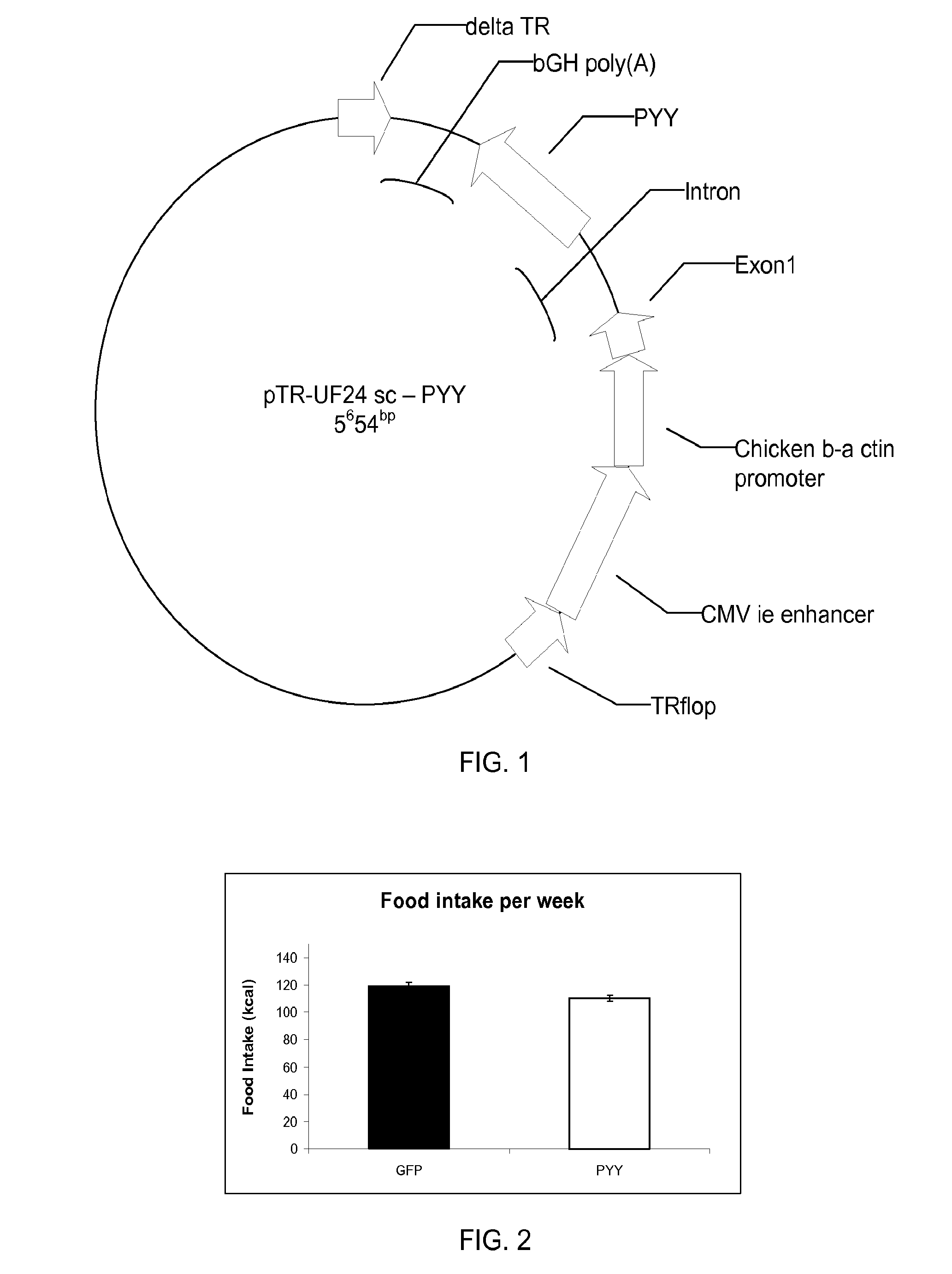Satiation peptide administration
a peptide and satiation technology, applied in the field of satiation peptide administration, can solve the problem that the satiation gut peptides would not be effective, and achieve the effect of reducing the number of peptides
- Summary
- Abstract
- Description
- Claims
- Application Information
AI Technical Summary
Benefits of technology
Problems solved by technology
Method used
Image
Examples
example 1
PYY Gene Therapy
[0025]Peptide YY (PYY) is a satiation gut peptide secreted from the neuro-endocrine L cells from the small intestine and colon epithelia. PYY is secreted into the blood stream and subsequently activates Y receptors in the arcuate nucleus of the hypothalamus thus inducing satiation. In the pilot study, in addition to the plasma, we have also detected PYY in saliva in naïve, untreated mice, while at the same time identifying the respective Y2 receptor in the tongue epithelia. To the inventors' knowledge, these are novel findings which lead to the following hypothesis: long-term expression of genes coding for satiation peptide in salivary gland will reduce food intake and body weight in obese animal.
[0026]In order to overexpress PYY, a rAAV vector was constructed harboring the pre-pro-Peptide YY gene (FIG. 1). rAAV-PYY was administered into the salivary glands through the salivary ducts. Injection of rAAV-PYY resulted in a long-term (up to 6 months) expression of Peptid...
example 2
Long-term Peptide YY Gene Therapy: Addressing Existing Controversy
[0028]Peptide YY (PYY) is a satiation gut hormone released postprandially mainly by the gut. The effects of acute and chronic administration of PYY are controversial. Several groups have found a significant decrease in food intake (FI) and body weight (BW) in animal experiments and in human trials, while other groups have been unable to reproduce this data. The controversy can be related to several behavioral factors including acclimatization and stress, as well as varying experimental conditions. To eliminate these factors and to address the effect of long-term overexpression of PYY we have develop animal models, C57BL / 6 mice, with either homotopic or ectopic expression of pre-pro-PYY transgene delivered by a single injection of a viral vector. For the enhanced homotopic expression, the vector was delivered through superior mesenteric artery (SMA) to target the colon and small intestine where PYY is normally produced...
example 3
Administration of Satiation Gut Peptides to Mouth
Introduction
[0029]Satiation gut peptides are secreted into the bloodstream from the small intestine and colon in response to food intake (FI). Their main effect is to induce satiety by activation their specific receptors in the satiety center in the hypothalamus. The most important satiation gut peptides are Peptide YY (PYY), Glucagon-like Peptide 1 (GLP-1), Oxyntomodulin (OXM), and Cholecystokinin (CCK). Acute supplemental therapy with satiation gut peptides reduces FI and body weight (BW) in obese animal models as well as in lean and obese human subjects. Several clinical trials utilizing satiation peptide supplement therapy are currently under way. Unfortunately, the delivery methods of these peptides (iv injections) showed significant side effects and poor adherence. In the pilot study, in addition to the plasma, we have also detected PYY in saliva in naïve, untreated mice, while at the same time identifying the respective Y2 rece...
PUM
| Property | Measurement | Unit |
|---|---|---|
| Time | aaaaa | aaaaa |
| Time | aaaaa | aaaaa |
| Concentration | aaaaa | aaaaa |
Abstract
Description
Claims
Application Information
 Login to View More
Login to View More - R&D
- Intellectual Property
- Life Sciences
- Materials
- Tech Scout
- Unparalleled Data Quality
- Higher Quality Content
- 60% Fewer Hallucinations
Browse by: Latest US Patents, China's latest patents, Technical Efficacy Thesaurus, Application Domain, Technology Topic, Popular Technical Reports.
© 2025 PatSnap. All rights reserved.Legal|Privacy policy|Modern Slavery Act Transparency Statement|Sitemap|About US| Contact US: help@patsnap.com



